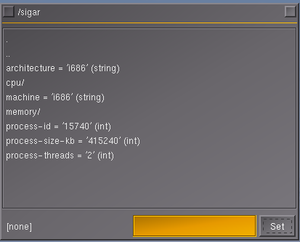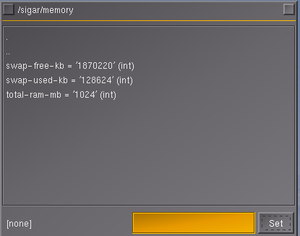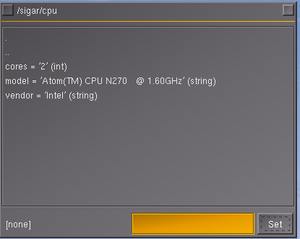Towards better troubleshooting
| Troubleshooting |
|---|
These are some ideas towards better troubleshooting that we usually come up with after each release to improve the quality of end-user bug reports. Most of these are fairly trivial to implement, it just seems that we don't typically have a need for them until someone shows up having a real problem who is not able to build from source... It mostly boils down to showing additional information in the about dialog, or including it in the startup log file created in $FG_HOME, or maybe even making it available in the new crash reporting tool eventually.
You may also want to check out this post on the forum: Re:Helping users in the long term post on the forum ![]()
Background
Whatever release plan we come up with, it will never be able to solve our issues with respect to bug reporting/fixing. We have all the required infrastructure to do better here: the bugtracker, a forum, a mailing list and we even send crash reports - at least on windows. What we do not have are the people dealing with that. We need:
|
| whether we do frequent automated releases or single hand-picked releases, the Achilles heel for the whole process is going to be getting enough test data and processing it properly. — Thorsten Renk (Nov 19th, 2015). Re: [Flightgear-devel] Some thoughts about the release process.
(powered by Instant-Cquotes) |
| Usually reports range from 'FG sucks' all the way to suggested C++ patches to fix an issue (with a strong bias towards the former). Ironically, we get at the same time too little and too much information - too little, because often people just write a frustrated post that FG version X crashes all the time and they reverted to the previous version - so we know there is an issue — Thorsten Renk (Nov 19th, 2015). Re: [Flightgear-devel] Some thoughts about the release process.
(powered by Instant-Cquotes) |
| I feel that getting the information better organied and brought to the attention of the relevant maintainers would be the key to make better stable releases - but I am at a loss how to achieve that. — Thorsten Renk (Nov 19th, 2015). Re: [Flightgear-devel] Some thoughts about the release process.
(powered by Instant-Cquotes) |
| however we do it in the future - this is what I see as the most pressing issue to solve - how to improve the flow of information from users to developers without making everyone unhappy in the process. — Thorsten Renk (Nov 19th, 2015). Re: [Flightgear-devel] Some thoughts about the release process.
(powered by Instant-Cquotes) |
| Might sth like a bug-report (or maybe crash-report?) feature be of help? We got a lot of information in the property-tree, like GPU-drivers etc. For instance, do we have OS and stuff like that too? Might be fairly easy to put this important info into a tmp-file, and in the case we crash, add it to some kind of http-request to flightgear.org. An experience-report might be of help, what frequently asked questions do you pose all the time? + the red box... — chris (Nov 19th, 2015). Re: [Flightgear-devel] Some thoughts about the release process.
(powered by Instant-Cquotes) |
| we should absolutely stop telling anyone to edit preferences.xml in FG_ROOT; any documentation or advice which says to should be changes ASAP.
— zakalawe (Sat Oct 26). Re: NavCache:init failed:Sqlite error:Sqlite API abuse.
(powered by Instant-Cquotes) |
Trivial
These are already available in the property tree, i.e. just requires editing about.xml:
- Expose threading mode
 Not done
Not done - Expose renderer mode (classic vs. rembrandt / osgEarth)
 Not done
Not done - Expose availability of Built-in Profiler
 Not done
Not done - show location of $FG_HOME in help/about dialog as a button to open it via file explorer ?
- show checksum of preferences.xml using the md5() Nasal API in the About dialog to ensure that people didn't tamper with it
- consider adding the checksum of preferenfces.xml to the binary, so that startup code can identify if files were modified that should not be changed
- should show if fgfsrc is available/used
- use intel detection heuristics and adapt those to detect AMD/ATI cards and show a startup warning to inform the user that PUI/styling may interfere with effects/shaders
- we keep seeing people who install mismatching versions of aircraft/fgfs - introduce a version-check property so that -set.xml files can encode version requirements, which are checked by a script in $FG_ROOT/Nasal [1]

Better version info
- add boost version info to a property and show it in help/about dialog
More logging
| Would it be possible to print the command line options FlightGear has been started with into the log file? At least from log-level "info" on upward. This would make helping users with issues a tad more easy. They would not have paste two files, the log plus the command line options. And the people trying to help would not need to explain how to gather the command line options. Which is not easy with with a bunch of launchers out there. It also would reduce the need for each of those said launchers to implement a feature to print the command line options. — Alex D-HUND (Jan 12th, 2016). [Flightgear-devel] Feature request - Logging / debugging.
(powered by Instant-Cquotes) |
This is a valid request, but there is complication in how various files and options are combined. There are two ways to do this:
— James Turner (Jan 12th, 2016). Re: [Flightgear-devel] Feature request - Logging / debugging.
(powered by Instant-Cquotes) |
Core changes


These will typically require changes on the C++ side, but would still be good to have whenever someone makes a bug report:
- provide a startup option/property to disable aicraft-set.xml Nasal code for troubleshooting purposes
- log frequency of Nasal callback invocation to the console to detect fdm coupled code ?
- dump node-specific osg camera stats to the console/log file (or even splash screen) during startup for the scenery/aircraft ROOT nodes [2]

- separate OpenGL/GLSL logging/log file for troubleshooting graphics related startup errors rendering FG useless (e.g. faulty drivers) [3]

- case-sensitive path checking [4]

- write the current pid (process ID) to the property tree, so that this can be used for debugging purposes (or even just for the suffix of log files)
 Not done
Not done - add startup options to override/ignore startup files and trigger a navdb cache rebuild [5]

 Not done
Not done - expose number of active timers/listeners[6]
 Not done
Not done - introduce a tag for FDM properties to optionally notice listeners being tied to FDM rate, as per [7]

- provide support for an optional TRACECB (callback) mode where multiple identical callbacks are reported ?
 Not done
Not done - we could also provide a property and use it as a "soft limit" for the number of listeners per property before a warning is shown, e.g. ~20-50 ?
 Not done
Not done
| I used two places to check how many Uniforms are created. EDXH (Isle of Helgoland in the North Sea) - barely any scenery; And KSFO with AI Traffic enabled, you know the scenery complexity.At EDXH, the Effect system attaches approx. 1500 Listeners to the property tree but only to 17 unique properties. At KSFO, the Effect system attaches some 10000 Listeners to the property tree - but also only to 17 unique properties. That's with shader quality set to zero (all off).
On my old Laptop, (1.6GHz dual core, GeForce Go 7400, 3Gb RAM) FlightGear has becom barely usable over the last few years. Framerates of max 20 at EDXH and single digits at KSFO. — Torsten Dreyer (2014-09-04). Re: [Flightgear-devel] crash in SGPropertyNode::fireValueChanged.
(powered by Instant-Cquotes) |
- Subsystem-level Memory Tracking for FlightGear (RAM/VRAM, CPU/GPU utilization)
 Not done
Not done - For better diagnostics, and better end-user bug reports, we could consider exposing a cross-platform process and system utilities module via Nasal/CppBind, such as e.g. psutil (Windows, MacOS & BSD/Unix)
 Not done
Not done - Nasal callback tracking (timers/listeners) [8]

- Nasal callback tracing, i.e. identical callbacks being called more than once per frame ?
- Expose scenery version info [9]
 [10]
[10] 
 Not done
Not done - Expose all startup arguments (would just be copied to a single property) and log them to the log file [11]
 Not done
Not done - Expose complete content of fgfsrc (could be read into the property tree)
 Not done
Not done - Expose cmake/compiler flags
 Not done
Not done - Expose release/debug build info (osg,simgear & fg)
 Not done
Not done - Expose architecture (32bit/64 bit) e.g. via __i386__ and __x86_64__ on Intel or via cmake [12]
 [13]
[13]  Not done
Not done - Expose amount of physical RAM available
 Not done
Not done - Expose amount of used RAM
 Not done
Not done - Expose degree of swapping
 Not done
Not done - Provide some means to show GLSL errors in a dedicated place, i.e. the loglist ?
 Not done
Not done - Maybe provide an option to attach the startup log file to a flight recorder "tape" so that people can more easily share reproducible flights ?
- Keep track of Nasal callbacks running via timers/listeners and maintain a list of origin (FILE/LINE, handle/identifier) so that we can inspect a list of "Nasal processes" [14]

- Investigate providing support for Nasal backtraces across timers/listeners as per Philosopher's posting [15]

- Extend Initializing Nasal early to provide a startup mode where the Nasal engine will be fully shut-down at run-time for better troubleshooting
Property ownership
Need a way to register property ownership:
| That's because the property is normally not under user control but set by the weather system. You have to stop the weather system before you can set it.
And other values are affected too - most of the environment in fact — Thorsten (Jan 16th, 2016). [[16]
(powered by Instant-Cquotes) |
Version checking
| Is there a way to bypass, fool or add multiple version #'s to VERSION file in the data folder so one can start any version of FG without having to edit that file every time? |
Nasal
| it's relatively easy to do bad things unintentionally. Like tie a bit of code to an FDM property and run updates of a display 120 times per second rather than the 30 times you actually need. Like start a loop multiple times so that you update the same property 30 times per frame rather than the one time you actually need. It's actually pretty hard to catch these things, because the code is formally okay, does the right thing and just eats more performance than necessary, and there's no simple output telling you that you're running 30 loops rather than the one you expect. — Thorsten Renk (Feb 1st, 2016). Re: [Flightgear-devel] Designing a thread-safe property tree API.
(powered by Instant-Cquotes) |
Canvas
- Canvas/Element baseclass: SGTimeStamp/PropertyObject for sampling the duration of each update step [23]

- make canvas optional [24]

- load Canvas/cppbind bindings on demand [25]#p265730] ]

- add draw masks for Canvas placements [26]

Runtime stuff
- provide a switch to enable/disable updating of canvas/groups on/off (or placements?), to help with troubleshooting
- Investigate extending Canvas::Element to optionally keep track of memory required for each element (use/sub-class osg::ref_ptr), so that we can provide some runtime info
 Not done
Not done - Provide a means to list all running Nasal callbacks invoked via timers/listeners [27]

 Not done
Not done - Extend FGStatsHandler to expose Nasal GC stats via osg::StatsHandler
 Not done
Not done
| The built-in osgviewer stats can be extended with custom stats, that works by subclassing osg::StatsHandler, this is already done in $FG_SRC/src/Viewer/FGEventHandler.hxx#L14 The class can be extended to add your own stats via osgViewer::StatsHandler::addUserStatsLine() |
- Canvas::Element/Canvas::Group should be extended to gather SGTimeStamp-based stats for each group/element, so that people can better tell what's going on behind the scenes [28]

 Not done
Not done - Use a separate draw mask for cockpit panels (e.g. via a corresponding XML attribute that serves as a marker), so that the impact of heavy cockpits can be better evaluated
 Not done
Not done - Whenever there's an exception while booting, we should try to re-init the sim and increase the log level to provide crashrpt with better info [29]

